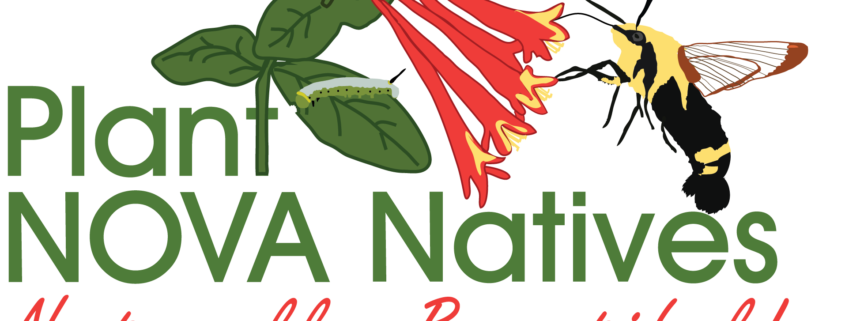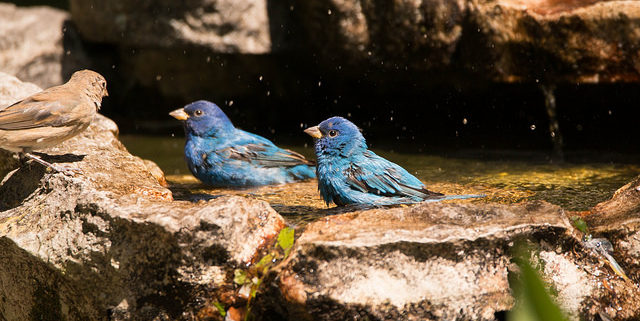Jerry Nissley
When is a jewel not a gem? When it’s a weed—at least that’s what I thought at first. Alas, the common jewelweed.
So what, then? Jewelweed is a common widespread plant that occurs in most moist, semi-shady areas throughout northern and eastern North America. Some people may call it an invasive native plant. So why take the time to write about it? Well, here’s what happened to me one day this summer, which may be an all too familiar occurrence for you as well.
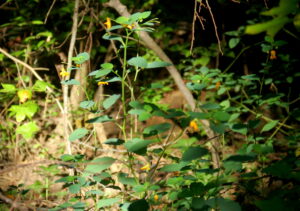
Photo 1, by Jerry Nissley
Friends and family know I recently completed the VMN program and frequently send me pictures of plants or animals to identify. Does that happen to you too? But no worries—I love the challenge. So one day a friend sends a single, iPhone picture depicting a lovely specimen she found of what she thinks is a yellow lady slipper. “Please confirm?” she asks.
I know only enough to know it does not look like one of the three lady slippers known to grow in Northern Virginia. So I send the picture to Martha Garcia, a fellow VMN who happened to present her wonderful FMN final class project on Lady Slippers, from which I learned that Lady Slippers are orchids. Martha did not believe it to be a lady slipper, but the picture looked enough like an orchid that she was interested in additional photos.
“Yay,” I say—an opportunity for “field work”! I grab my SLR and tripod to hunt down the suspect at the obscure Kirk Park in Alexandria. Of course, I am looking for something of magnificent splendor tucked beside a log but nothing like that do I find. Eventually my eyes refocus with a wider aperture and catch glimpse of little orange dots on a bushy vine by the side of the path (see Photo 1). The flowers are not even an inch across, they are tiny, and they are on a bush. Alas, my chance at fame and fortune melted away with the summer heat after realizing I was not about to discover a new orchid. Ha, of course not—why would I even think that?
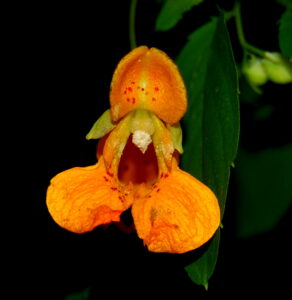
Photo 2, by Jerry Nissley
However, upon returning home (and to reality), I reviewed the photos, looked up information, and discovered the plant to be a jewelweed, a.k.a. touch-me-not or orange balsam. It soothes poison ivy rash, the seeds explode into the air when touched, hummingbirds are the primary pollinator, it has the face of an orchid (sort of), and the leaves shimmer under water—what is not to like? I found the so-what factor, and why I came to consider it a hidden gem after all follows.
Jewelweed (Impatiens capensis)
It often forms dense, pure stands in floodplain forests and around the forested edges of marshes and bogs. Jewelweed also colonizes disturbed habitats such as ditches and road cuts. It can be an aggressive competitor in its favored habitats, and is one of the few native North American plants that has been shown to compete successfully against garlic mustard (Alliaria petiolata), a non-native invasive weed that threatens many eastern North American forests.
Jewelweed is an herbaceous plant that grows 3 to 5 feet tall and blooms from late spring to early fall. The flowers are orange (sometimes blood orange or rarely yellow) with a three-lobed corolla; one of the calyx lobes is colored similarly to the corolla and forms a hooked conical spur at the back of the flower (see Photo 2). Plants may also produce non-showy cleistogamous flowers, which do not require cross-pollination. The principal advantage of cleistogamy (closed flowers) is that it requires fewer plant resources to produce seeds than chasmogamy (open flowers), because development of petals, nectar and large amounts of pollen is not required. This efficiency makes cleistogamy particularly useful for seed production on unfavorable sites or in adverse conditions. Impatiens capensis has been observed to produce only cleistogamous flowers after being severely damaged by grazing.
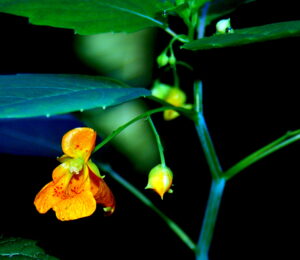
Photo 3, by Jerry Nissley
The round stems are smooth and succulent, semi-ranslucent, with swollen or darkened nodes on some plants. The leaves are alternate and simple and have teeth on the margins. The seed pods have five valves which coil back rapidly to eject the seeds in a process called explosive dehiscence. This reaction is where the name ‘touch-me-not’ comes from; in mature seed pods, dehiscence can easily be triggered with a light touch. The leaves appear to be silver-blue or ‘jeweled’ when held underwater or in morning dew (see Photo 3), which is possibly where the jewelweed name comes from.
Nectar spurs are tubular elongations of petals and sepals of certain flowers that usually contain nectar (see Photo 4). Flowers of Impatiens capensis have these nectar spurs. Nectar spurs are thought to have played a role in plant-pollinator coevolution. Curvature angles of nectar spurs of Impatiens capensis are variable. Research shows this angle varies from 0 degrees to 270 degrees. The angle of the nectar spur is very important in the pollination of the flower and in determining
the most efficient pollinator. Hummingbirds are major pollinators. They remove more pollen per visit from flowers with curved nectar spurs than with perpendicular nectar spurs. Ruby-Throated hummingbirds are not the only pollinators of Impatiens capensis. The flowers attract long-tongued bees, including bumblebees and honeybees. Swallowtail butterflies are occasional visitors. Sometimes bumblebees will steal nectar by chewing holes near the spur of the flower. Various smaller insects (e.g., Syrphid flies and ants) will visit the same holes to steal nectar. The caterpillars of several moths feed on the foliage, including Euchlaena obtusaria (Obtuse Euchlaena), Spilosoma latipennis (Pink-Legged Tiger Moth), Trichodezia albovittata (White-Striped Black), and Xanthorhoe lacustrata (Toothed Brown Carpet). Seeds are eaten by birds and mice and White-Tailed Deer browse on the foliage. Photo 5 shows an ant taking a morning sip of nectar.
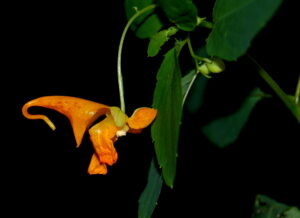
Figure 4. Photo by Jerry Nissley

Figure 5. Photo by Jerry Nissley
Along with other species of jewelweed, the juice of the leaves and stems is a traditional Native
Peoples remedy for skin rashes, including poison ivy. The effectiveness of its use to prevent the development of a rash after short-term exposure to poison ivy has been supported by peer-reviewed study and is likely due to the plant containing saponins. These studies also found that some individuals have sensitivity to jewelweed which can cause a more severe rash. To treat a rash, gather some of the whole jewelweed plant and macerate well until it becomes wet in your hands. Apply the wet plant matter to the rash area directly. Leave on and repeat applications as needed. Jewelweed helps counterbalance the oils in poison ivy. It has also been used as an agent to promote blood flow, for post-childbirth, joint pain, bruises and swelling, and athlete’s foot.
As an aside, most saponins, which readily dissolve in water, are poisonous to fish. Therefore, in ethnobotany, they are primarily known for their use by indigenous people in obtaining aquatic food sources. Cultures throughout the world have used fish-killing plants, mostly those containing saponins, for fishing. Although now prohibited by law, fish-poison plants are still widely used by indigenous tribes in Guyana. Many of California’s Native People tribes traditionally used soaproot, (genus Chlorogalum) and/or the root of various yucca species, which contain saponin, as a fish poison. They would pulverize the roots, mixing in water to create foam and then add the suds to a stream. This would kill, or incapacitate, the fish, which could be gathered easily from the surface of the water.
Jewelweed makes a lovely addition to native plant gardens that are located in moist, partially shaded areas. Not only are the flowers aesthetically pleasing, so are the hummingbirds, bumblebees, and butterflies that are attracted to the flowers. Jewelweed can be used to fill in empty spaces in the garden that might otherwise be taken over by non-native weeds. Jewelweed can be propagated easily by direct sowing of fresh seed in early fall. Once established, a patch of jewelweed will maintain itself through annual seed production.
So there you have it. Once again, something that may have gone unnoticed because of its diminutive size or under-appreciated because it’s “just another woodland weed,” indeed turns out to be a resource for native insects, animals, and humans. But who would have known? I had to become aware, get out there, take a look, and do my homework to understand the intricacies of everything jewelweed. At the risk of sounding corny, moments like this are my reward for getting involved with the VMN program. I may have never taken the time to discover the importance of this tiny jewel of the forest. So maybe it was a new discovery after all, if perhaps only for me. How many more ‘new discoveries’ are out there?
References
https://www.fs.fed.us/wildflowers/plant-of-the-week/impatiens_capensis.shtml
https://en.wikipedia.org/wiki/Impatiens_capensis
http://www.illinoiswildflowers.info/wetland/plants/or_jewelweed.htm
https://www.ncbi.nlm.nih.gov/pmc/articles/PMC2682495/
https://en.wikipedia.org/wiki/Saponin


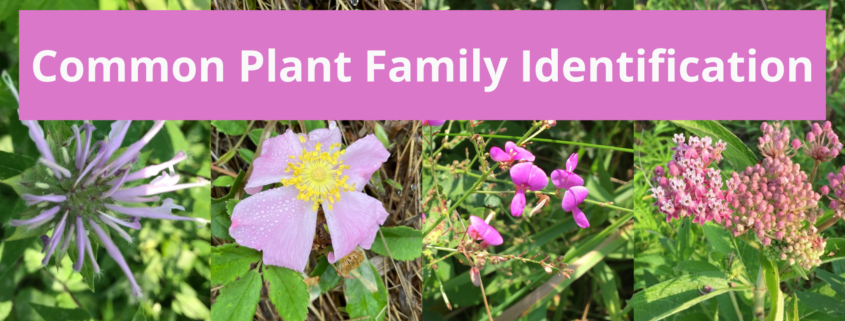
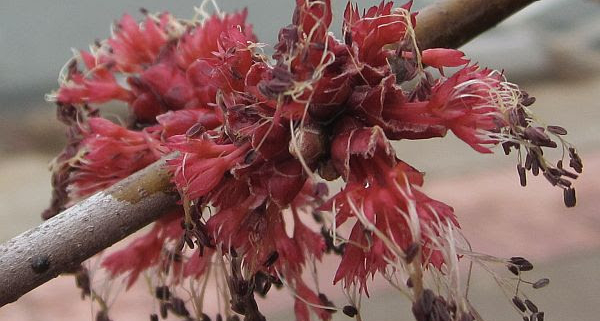

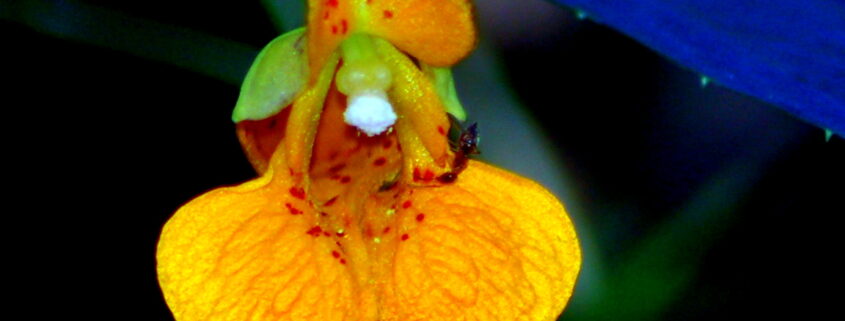






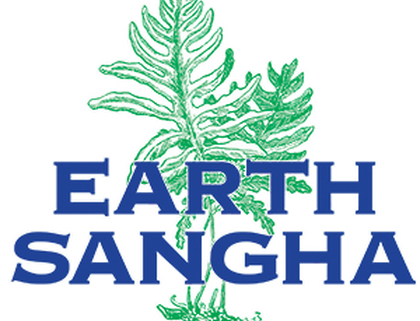

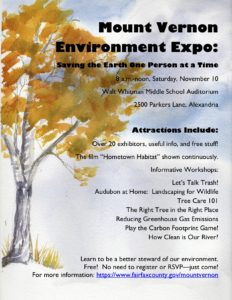 Please
Please 